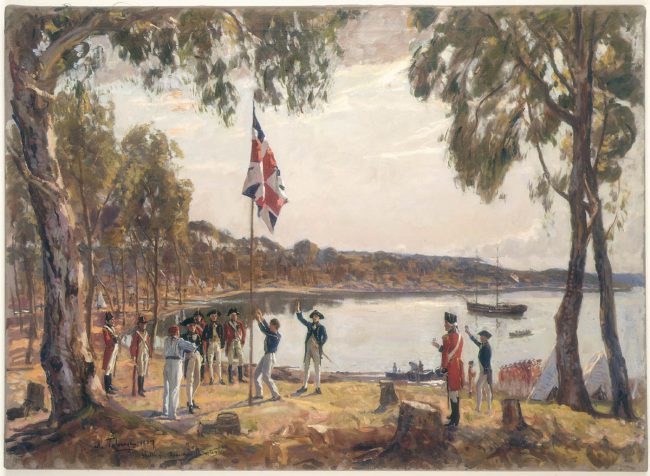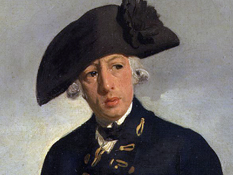On May 13, 1787, the First Fleet commanded by Captain (later Admiral) Arthur Phillip, left Portsmouth, England, to found a penal colony that became the first European settlement in Australia.
Arthur Phillip – Early Years
Arthur Phillip was born in the parish of London in 1738 and enrolled at Greenwich School for the sons of seamen. After two years at sea his apprenticeship in the mercantile service was completed and afterwards, he remained aboard as Fortune undertook an outward trading voyage to Barcelona and Livorno carrying salt and raisins, returning via Rotterdam with a cargo of grains and citrus. He then enlisted in the Royal Navy and was assigned the rank of ordinary seaman aboard the 68-gun HMS Buckingham. As member of this crew, Phillip in the Seven Years’ War, especially the Ballte of Minorca. He was promoted to Lieutenant and was posted as second lieutenant aboard HMS Egmont, a newly built 74-gun ship of the line.
First Command
Arthur Phillip joined the Portuguese Navy as a captain and served in the War against Spain. Also he was recalled to active service in 1778 as Britain was again at war. He obtained his first command, HMS Basilisk and was promoted to post-captain and given command of HMS Europa in the early 1780s. From October 1784 to September 1786 he was employed by Nepean, who was in charge of the Secret Service relating to the Bourbon Powers, France and Spain, to spy on the French naval arsenals at Toulon and other ports. There was fear that Britain would soon be at war with these powers as a consequence of the Batavian Revolution in the Netherlands.
A New British Colony
Back then, Lord Sandwich and the President of the Royal Society, Sir Joseph Banks, were advocating establishment of a British colony in New South Wales. The British Government took the decision to found the Botany Bay colony in mid-1786. Lord Sydney, as Secretary of State for the Home Office, was the minister in charge of this undertaking, and in September 1786 he appointed Phillip commodore of the fleet which was to transport the convicts and soldiers who were to be the new settlers to Botany Bay. Upon arrival there, Phillip was to assume the powers of Captain General and Governor in Chief of the new colony. A subsidiary colony was to be founded on Norfolk Island, as recommended by Sir John Call, to take advantage for naval purposes of that island’s native flax and timber.

Algernon Talmage, The Founding of Australia. By Capt. Arthur Phillip R.N. Sydney Cove, Jan. 26th 1788. Oil sketch.
Commander of the First Fleet
In October 1786, Arthur Phillip was appointed captain of HMS Sirius and named Governor-designate of New South Wales, the proposed British colony on the east coast of Australia, by Lord Sydney, the Home Secretary. The 11 ships of the First Fleet set sail on 13 May 1787. The leading ship, HMS Supply reached Botany Bay setting up camp on the Kurnell Peninsula, on 18 January 1788. Phillip soon decided that this site, chosen on the recommendation of Sir Joseph Banks, who had accompanied James Cook in 1770, was not suitable, since it had poor soil, no secure anchorage and no reliable water source.[4] After some exploration Phillip decided to go on to Port Jackson, and on 26 January the marines and convicts were landed at Sydney Cove, which Phillip named after Lord Sydney.
First Govenor of New South Wales
Arthur Phillip became the first Governor of New South Wales and founder of the British penal colony that later became the city of Sydney, Australia. As the first governor of New South Wales, Phillip struggled with rebellious convicts and troops and—until the middle of 1790 – with the threat of famine. However, he successfully created a permanent community. Despite his conciliatory policy toward the native Aborigines, he failed to establish peace between the settlers and the natives. He returned to England in 1792 because of poor health, but he saw further action at sea. In 1805, aged 67, he retired from the Navy with the rank of Admiral of the Blue, and spent most of the rest of his life at Bath. He continued to correspond with friends in New South Wales and to promote the colony’s interests with government officials. He died in Bath in 1814 at age 75.
Governor Arthur Phillip and the Eora [HD] Saturday Extra, ABC RN, [9]
References and Further Reading:
- [1] B. H. Fletcher, ‘Phillip, Arthur (1738–1814)’, Australian Dictionary of Biography, Volume 2, Melbourne University Press, 1967, pp 326–333.
- [2] The Voyage of Governor Phillip to Botany Bay – National Museum of Australia
- [3] Arthur Phillip at Britannica
- [4] James Cook and the Great Barrier Reef, SciHi Blog
- [5] The Voyage of Governor Phillip to Botany Bay – National Museum of Australia
- [6] Arthur Phillip, The Voyage of Governor Phillip to Botany Bay with an Account of the Establishment of the Colonies of Port Jackson and Norfolk Island (1789), via Wikisource
- [7] Arthur Phillip at Wikidata
- [8] Works by or about Arthur Phillip at Internet Archive
- [9] Governor Arthur Phillip and the Eora [HD] Saturday Extra, ABC RN, ABC News (Australia) @ youtube
- [10] Timeline of City Founders, via DBpedia and Wikidata







Pingback: Whewell’s Gazette: Year 2, Vol: #40 | Whewell's Ghost